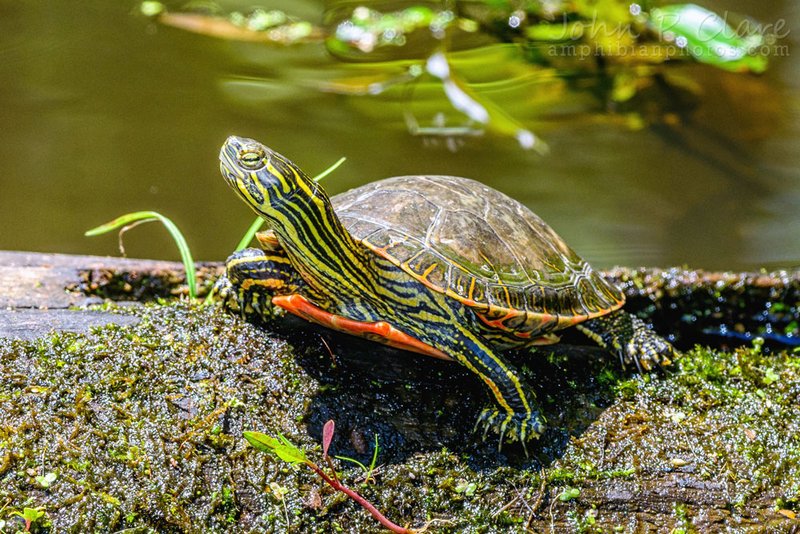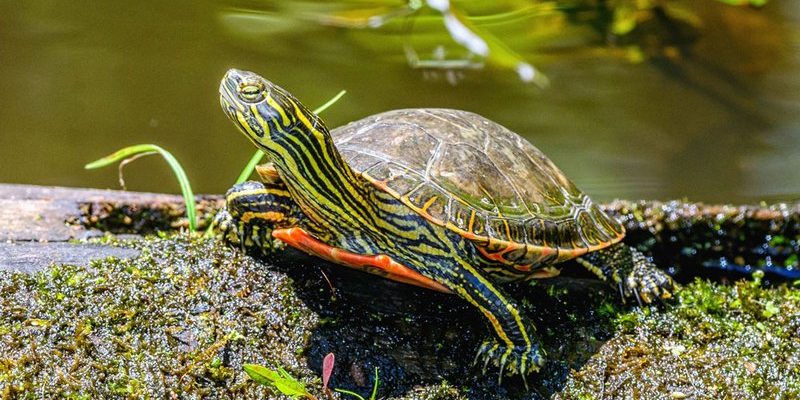
Imagine sitting by a serene lake on a sunny day, watching a painted turtle basking on a rock. It’s not just any turtle; this one has a striking blend of colors. Its shell, often adorned with yellow or red stripes, makes it a stunning sight against the backdrop of greenery and water. But there’s more to these turtles than just good looks! Understanding their behavior and habits helps appreciate the role they play in their ecosystems. Ready to learn more? Let’s get started!
1. Unique Appearance
The painted turtle is one of the most visually appealing turtles in North America. Picture a smooth, flat shell that can display a beautiful range of colors, mainly black or olive, decorated with bright orange, yellow, and red markings. These vibrant hues aren’t just for show; they help the turtle blend into its habitat while also communicating with other turtles.
This species has distinctive patterns on its skin as well. The skin itself can be greenish or black and is often lined with bright yellow or red stripes. Looking at a painted turtle lounging on a rock, you might wonder if it’s part of a colorful art project! These striking colors can also vary from one turtle to another, making each one unique.
2. Habitat and Range
You might be surprised to learn that painted turtles are quite adaptable! They thrive in a variety of habitats. You’ll find them basking in the sun at lakes, ponds, marshes, and even slow-moving rivers. Their habitat choices often depend on climate and available food sources.
Across North America, painted turtles can be spotted from southern Canada down to northern Mexico. Their ability to adapt to different environments helps them avoid many predators and find ample food. Honestly, who wouldn’t want to live in such a diverse range of beautiful locations?
3. Diet and Feeding Habits
Let’s talk food! Painted turtles are omnivores, which means they enjoy a mix of plants and animals. They munch on everything from aquatic plants and algae to insects, small fish, and even crustaceans. You might see them grazing on lily pads or snapping up little bugs that skim across the water’s surface.
Their feeding habits can vary based on the season. In warmer months, they feast on a wide variety of fresh plants and insects. When temperatures drop, they often switch to a more plant-heavy diet, as many animal sources become less available. It’s a survival strategy that works well for these colorful critters!
4. Social Behavior
You might imagine turtles as solitary creatures, but painted turtles are surprisingly social! They often bask together on logs or rocks, soaking up the sun. This social behavior not only helps them keep warm but also plays a role in mating and establishing hierarchies within their groups.
When basking, you’ll notice that some turtles are more dominant, getting the best spots in the sun. They’ll often use body language, like head bobs or shell nudges, to communicate with each other. It’s a whole world of turtle etiquette out there!
5. Reproduction and Lifespan
Painted turtles have an interesting reproductive cycle. Mating usually occurs in spring, and females can lay anywhere from 3 to 20 eggs in a single clutch. They often dig nests in sandy or loose soil, which can take some time! After laying their eggs, the females head back to the water, leaving the eggs to incubate in the sun.
You might be wondering how long these turtles live. On average, painted turtles can live for 20 to 30 years, but some have even been known to live beyond 50 years under ideal conditions. That’s a long time to enjoy basking and swimming in their watery homes!
6. Hibernation Habits
Prepare for a fascinating twist: painted turtles can hibernate! As temperatures drop in the fall, these turtles dive into the mud at the bottom of ponds to hibernate through the winter months. This process helps them survive when their environment freezes over.
During hibernation, their metabolism slows down significantly, allowing them to go for months without food. You might be curious about how they breathe during this time. Painted turtles can absorb oxygen through their skin, making it possible for them to survive underwater. Isn’t that clever?
7. Conservation Status
Despite their resilience, painted turtles face some challenges. Habitat destruction, pollution, and road mortality are significant threats to their populations. You might be wondering how you can help. Simple actions like protecting wetland habitats, reducing plastic use, and supporting local conservation efforts can make a big difference.
Many organizations work to rescue and rehabilitate painted turtles, and you can also get involved in local clean-up efforts. Every bit of action helps keep our ecosystems healthy and these beautiful turtles thriving.
8. Fun Facts and Myths
There’s a lot more to painted turtles than meets the eye! Here are some fun facts that might surprise you:
- Colorful Names: The painted turtle gets its name from its bright colors and patterns.
- Not Just Water Dwellers: They are excellent climbers and can scale steep banks to get to their basking spots.
- Team Players: Painted turtles often work together to escape predators, using their social skills to avoid danger.
In some cultures, turtles symbolize wisdom and longevity, adding to their mystique. They have been featured in various myths and stories, showcasing their significance in many traditions.
The painted turtle is more than just a pretty face in the water. With its vibrant colors, unique behaviors, and fascinating lifestyle, this creature is a true gem of nature. Understanding these turtles helps us appreciate the role they play in our ecosystems and raises awareness about the importance of conservation.
Next time you spot a painted turtle basking on a rock, take a moment to appreciate not just its beauty but its remarkable life story. Who knows? You might just be inspired to help protect its home!

